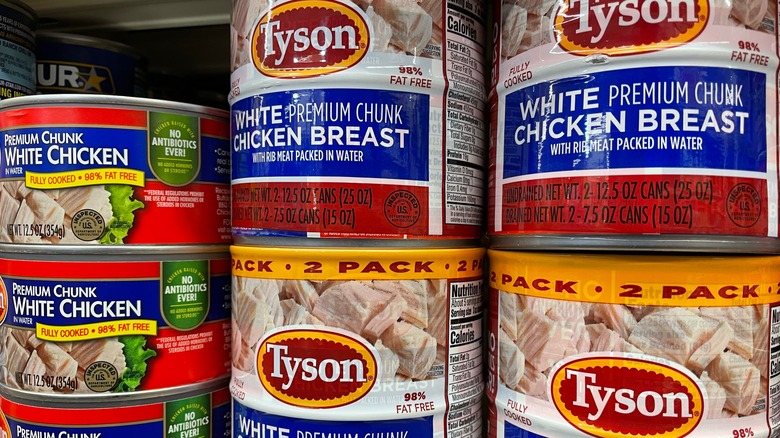This Popular Protein Has An Unexpected Amount Of Potassium
We often hear about the importance of protein, fiber, or calcium, amongst other essential vitamins and minerals. One mineral that doesn't get as much chatter, however, is potassium. This doesn't seem fair considering the fact that potassium is involved in nearly every function of the body, including those of our kidneys, heart, muscles, nerves, and more, according to the National Institutes of Health (NIH). No matter your age, getting sufficient amounts of potassium is important. Even babies 6 months of age and younger are recommended to get 400 milligrams of potassium every day. For adults, the recommended daily intake is between 2,600 milligrams for women and 3,400 milligrams for men.
Not getting enough potassium can put one at risk for hypertension, kidney stones, increases in blood sugar levels, and loss of calcium within our bones. In more serious cases, some people may get so little of the mineral that they're diagnosed with a potassium deficiency referred to as hypokalemia. Thankfully, potassium can be found in a wide range of foods, such as potatoes, squash, kidney beans, milk, orange juice, and much more. Potassium can also be found in many different meats. While protein may be the first essential nutrient that comes to mind when we think of meat or poultry, chicken is one protein that harbors a surprising amount of potassium.
Potassium content of cooked chicken versus canned chicken
Don't believe us? According to the U.S. Department of Agriculture (USDA), in 100 grams of skinless, boneless, cooked chicken breast, you'll find 343 milligrams of potassium. This equates to an approximately 3.5-ounce serving. How does this compare to another powerhouse potassium source: the banana? While the same 100-gram serving of raw banana takes the cake for potassium content over our cooked chicken, it's not by much. Rather, you'll find only 15 milligrams more of potassium in this sunflower-yellow fruit (via USDA).
If you opt for canned chicken, however, you'll be cutting that potassium content by more than half. Instead of the 343 milligrams found in cooked chicken breast, the same 100-gram serving of canned chicken with no broth contains only 153 milligrams of potassium (via USDA). With 359 milligrams of potassium found in the same-size serving of raw banana, the fruit really comes out on top when compared to canned chicken.
The relationship between potassium and sodium
Although canned chicken is still a viable source of potassium and protein, there's one ingredient to be wary of: sodium. In a 100-gram serving of skinless, boneless, cooked chicken breast, you'll get 47 milligrams of sodium (via USDA). In the exact same serving of broth-free canned chicken, you'll get more than ten times that amount at 482 milligrams of sodium (via USDA).
Sodium and potassium go hand in hand. The two of them help the body maintain a careful balance of fluid between the inside and the outside of our cells, according to Harvard T.H. Chan. Researchers from a 2011 study published in JAMA Internal Medicine looked at data pertaining to more than 12,000 adults from the Third National Health and Nutrition Examination Survey Linked Mortality File spanning from 1988 to 2006. A nearly 15-year follow-up period revealed that a total of 2,270 deaths had occurred, many of them related to heart disease. While the overconsumption of sodium or potassium alone poses its own potential health risks, the researchers noted that those with the highest sodium-to-potassium intake ratio were at greater risk for cardiovascular diseases and all-cause death. While chicken is a great source of potassium, because canned chicken contains higher amounts of sodium, it's best consumed in moderation.


